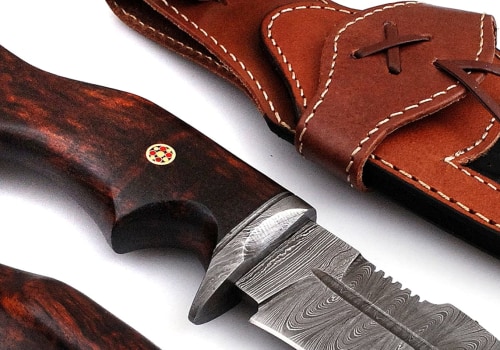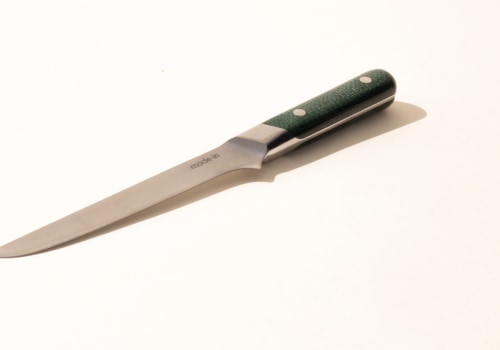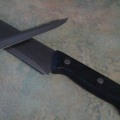The right knife can make a world of difference in the kitchen. From preparing food to cooking it, a chef's knife is one of the most important tools in the kitchen. But there's more to selecting the right knife than just picking out a set from the store. Crafting a chef's knife takes skill and knowledge, and each knife is unique and different from the next.
In this article, we'll take an in-depth look at chef's knives and explore the process of knife crafting. We'll discuss the different types of knives, including Japanese knives, German knives, and French knives, as well as the various materials used in knife making. We'll also explore the techniques involved in crafting a chef's knife, from the creation of the blade to the handle construction. Finally, we'll provide some tips for choosing the right chef's knife for your needs. Chef's knives are essential tools in any kitchen. From home cooks to professional chefs, having the right knife makes all the difference in getting the job done quickly and efficiently.
When buying a chef's knife, the most important factor to consider is the type of steel used. Different types of steel have different properties that make them better suited for different tasks.
Stainless steel
is the most common type of steel used for chef's knives because it is durable and resistant to corrosion. Carbon steel is another option, but it is more prone to rust and requires regular sharpening.Additionally, it is important to consider the size and shape of the blade. Chef's knives typically range from 6-12 inches in length and can be either straight or curved depending on the task. Some chef's knives also feature a bolster, which is a piece of metal that extends from the handle to the heel of the blade, providing additional weight and balance. Once you have chosen your knife, it is important to know how to use it properly. The most basic technique is known as the rocking motion, which involves using the tip of the blade to make small slicing motions while keeping the handle in one place.
This technique is often used for chopping vegetables or mincing herbs. Another common technique is called slicing, which involves using a long, sweeping motion with the entire length of the blade. This technique is useful for slicing meats or fish. It is important to maintain your chef's knife by keeping it sharp and clean. Regular sharpening helps keep the blade in good condition and prevents it from becoming dull over time.
Additionally, it is important to clean your knife after each use to prevent food from building up on the blade. Using a sharpening stone or honing rod can help keep your knife sharp between sharpenings.
Using Chef's Knives Safely
Chef's knives are a versatile tool used in the kitchen, but it is important to take safety precautions when handling them. Always use a cutting board when cutting, as cutting directly on countertops can damage both the countertop and the knife. When using a chef's knife, make sure to hold the handle firmly with your dominant hand and use your other hand to guide the blade.Never attempt to catch a falling knife or use it as a tool for any task other than cutting food.
Safety
should always be top of mind when using a chef's knife. It is important to use proper technique when handling the knife to avoid accidents. Keep your fingers away from the blade and always use a cutting board. Additionally, do not attempt to catch a falling knife, as this can lead to serious injury. It is also important to store your chef's knives properly.Store them in a safe place, such as a designated drawer or block, where they will not come into contact with other objects or people. Make sure that the blades are facing down and that the handles are in a secure position.
Different Types of Chef's Knives
Chef's knives are essential tools for any kitchen, and come in a wide range of shapes and sizes that can be used for specific tasks. The most common types of chef's knives are the Santoku, Chef's Knife, Paring Knife, and Bread Knife.Santoku
: This Japanese-style knife has a straight blade with a pointed tip and a wide belly that is great for slicing vegetables and fruits.Chef's Knife: This classic knife usually has an 8-10 inch blade with a curved edge that is great for chopping and mincing.
Paring Knife: This small knife typically has a 3-4 inch blade and is ideal for peeling vegetables and fruits.
Bread Knife: This long serrated knife is perfect for slicing bread and other foods with a hard crust.
Different Types of Chef's Knives
Chef's knives are an essential tool in any kitchen, and come in a variety of shapes and sizes designed for specific tasks. The most popular types of chef's knives include the Santoku, Chef's Knife, Paring Knife, and Bread Knife.Santoku
- This Japanese-style knife has a straight blade with a pointed tip and wide belly for slicing vegetables and fruits.Chef's Knife - This classic knife has an 8-10 inch blade with a curved edge for chopping and mincing.
Paring Knife - This small knife has a 3-4 inch blade that is ideal for peeling vegetables and fruits.
Bread Knife - This long serrated knife is used for slicing bread and other foods with a hard crust.
Having the right knife for the job is important in getting the job done quickly and efficiently. Understanding the features of different types of chef's knives can help you choose the right one for your kitchen.
Using Chef's Knives Safely
Chef's knives are essential tools in any kitchen, and it is important to take the proper safety precautions when using them. Always use a cutting board when using a chef's knife, as cutting directly on countertops can damage both the countertop and the knife. When using the knife, always hold the handle firmly with your dominant hand, and use your other hand to control the blade.Never attempt to catch a falling knife or use it as a tool for any task other than cutting food. When using a chef's knife, it is also important to keep the blade sharp. Dull knives require more force to cut through food, which increases the risk of injury. To ensure your knife remains sharp, use a sharpening stone or whetstone regularly. Properly sharpening your knife will also make cutting easier and faster. By following these simple safety tips, you can ensure that you are using your chef's knife safely and effectively.
Different Types of Chef's Knives
Chef's knives come in a variety of shapes and sizes that are designed for specific tasks.The most common types include: Santoku – This Japanese-style knife features a straight blade with a pointed tip and a wide belly for slicing vegetables and fruits.
Chef's Knife
– This classic knife has an 8-10 inch blade with a curved edge for chopping and mincing.Paring Knife
– This small knife has a 3-4 inch blade that is ideal for peeling vegetables and fruits.Bread Knife
– This long serrated knife is used for slicing bread and other foods with a hard crust.Using Chef's Knives Safely
Chef's knives are essential tools in any kitchen, whether it's for a home cook or a professional chef. But it is important to use them safely so that you don't injure yourself or damage your knife.Cutting Board
When using a chef's knife, always use a cutting board to protect both the knife and the countertop. Cutting directly on the countertop can quickly dull and damage the blade, as well as leaving scratches or gouges in the surface.Handle FirmlyAlways hold the handle of the knife firmly with your dominant hand while you are cutting with it. This will give you better control of the blade and keep your fingers away from the sharp edge.
Catching Falling Knives
Never try to catch a falling knife. This could lead to serious injury if you are not careful.Additionally, knives should never be used for any task other than cutting food. Chef's knives are essential tools in any kitchen, but using them safely and properly is key to getting the best results. Knowing which type of knife to use for specific tasks and understanding how to maintain it will help ensure that your knife remains sharp and in good condition for years to come.







Leave Reply